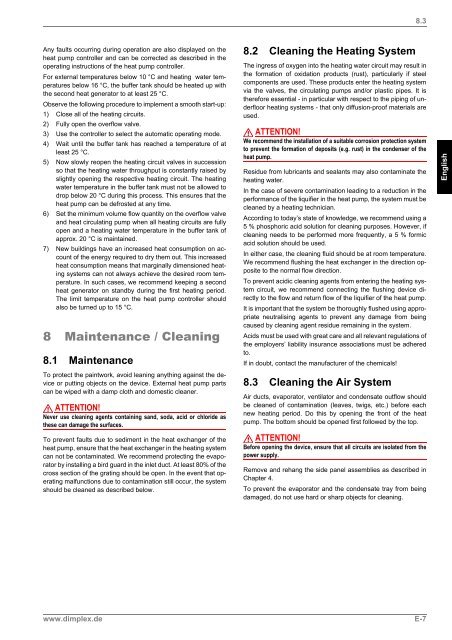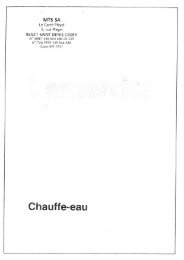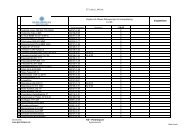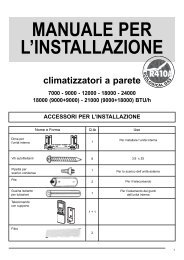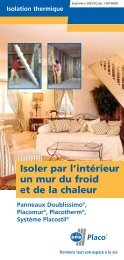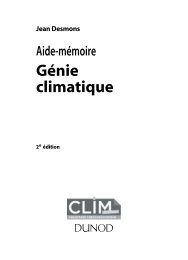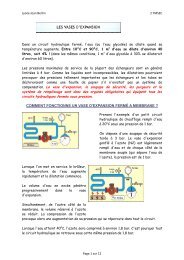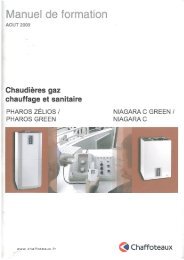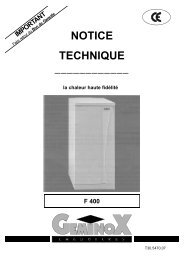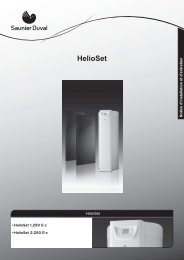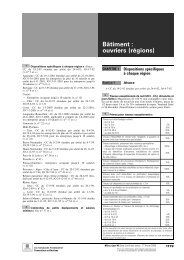Dimplex_LIH 22-26TE 3-sprachig D-GB-F.book - enrdd.com
Dimplex_LIH 22-26TE 3-sprachig D-GB-F.book - enrdd.com
Dimplex_LIH 22-26TE 3-sprachig D-GB-F.book - enrdd.com
Create successful ePaper yourself
Turn your PDF publications into a flip-book with our unique Google optimized e-Paper software.
8.3<br />
Any faults occurring during operation are also displayed on the<br />
heat pump controller and can be corrected as described in the<br />
operating instructions of the heat pump controller.<br />
For external temperatures below 10 °C and heating water temperatures<br />
below 16 °C, the buffer tank should be heated up with<br />
the second heat generator to at least 25 °C.<br />
Observe the following procedure to implement a smooth start-up:<br />
1) Close all of the heating circuits.<br />
2) Fully open the overflow valve.<br />
3) Use the controller to select the automatic operating mode.<br />
4) Wait until the buffer tank has reached a temperature of at<br />
least 25 °C.<br />
5) Now slowly reopen the heating circuit valves in succession<br />
so that the heating water throughput is constantly raised by<br />
slightly opening the respective heating circuit. The heating<br />
water temperature in the buffer tank must not be allowed to<br />
drop below 20 °C during this process. This ensures that the<br />
heat pump can be defrosted at any time.<br />
6) Set the minimum volume flow quantity on the overflow valve<br />
and heat circulating pump when all heating circuits are fully<br />
open and a heating water temperature in the buffer tank of<br />
approx. 20 °C is maintained.<br />
7) New buildings have an increased heat consumption on account<br />
of the energy required to dry them out. This increased<br />
heat consumption means that marginally dimensioned heating<br />
systems can not always achieve the desired room temperature.<br />
In such cases, we re<strong>com</strong>mend keeping a second<br />
heat generator on standby during the first heating period.<br />
The limit temperature on the heat pump controller should<br />
also be turned up to 15 °C.<br />
8 Maintenance / Cleaning<br />
8.1 Maintenance<br />
To protect the paintwork, avoid leaning anything against the device<br />
or putting objects on the device. External heat pump parts<br />
can be wiped with a damp cloth and domestic cleaner.<br />
ATTENTION!<br />
Never use cleaning agents containing sand, soda, acid or chloride as<br />
these can damage the surfaces.<br />
To prevent faults due to sediment in the heat exchanger of the<br />
heat pump, ensure that the heat exchanger in the heating system<br />
can not be contaminated. We re<strong>com</strong>mend protecting the evaporator<br />
by installing a bird guard in the inlet duct. At least 80% of the<br />
cross section of the grating should be open. In the event that operating<br />
malfunctions due to contamination still occur, the system<br />
should be cleaned as described below.<br />
8.2 Cleaning the Heating System<br />
The ingress of oxygen into the heating water circuit may result in<br />
the formation of oxidation products (rust), particularly if steel<br />
<strong>com</strong>ponents are used. These products enter the heating system<br />
via the valves, the circulating pumps and/or plastic pipes. It is<br />
therefore essential - in particular with respect to the piping of underfloor<br />
heating systems - that only diffusion-proof materials are<br />
used.<br />
ATTENTION!<br />
We re<strong>com</strong>mend the installation of a suitable corrosion protection system<br />
to prevent the formation of deposits (e.g. rust) in the condenser of the<br />
heat pump.<br />
Residue from lubricants and sealants may also contaminate the<br />
heating water.<br />
In the case of severe contamination leading to a reduction in the<br />
performance of the liquifier in the heat pump, the system must be<br />
cleaned by a heating technician.<br />
According to today’s state of knowledge, we re<strong>com</strong>mend using a<br />
5 % phosphoric acid solution for cleaning purposes. However, if<br />
cleaning needs to be performed more frequently, a 5 % formic<br />
acid solution should be used.<br />
In either case, the cleaning fluid should be at room temperature.<br />
We re<strong>com</strong>mend flushing the heat exchanger in the direction opposite<br />
to the normal flow direction.<br />
To prevent acidic cleaning agents from entering the heating system<br />
circuit, we re<strong>com</strong>mend connecting the flushing device directly<br />
to the flow and return flow of the liquifier of the heat pump.<br />
It is important that the system be thoroughly flushed using appropriate<br />
neutralising agents to prevent any damage from being<br />
caused by cleaning agent residue remaining in the system.<br />
Acids must be used with great care and all relevant regulations of<br />
the employers’ liability insurance associations must be adhered<br />
to.<br />
If in doubt, contact the manufacturer of the chemicals!<br />
8.3 Cleaning the Air System<br />
Air ducts, evaporator, ventilator and condensate outflow should<br />
be cleaned of contamination (leaves, twigs, etc.) before each<br />
new heating period. Do this by opening the front of the heat<br />
pump. The bottom should be opened first followed by the top.<br />
ATTENTION!<br />
Before opening the device, ensure that all circuits are isolated from the<br />
power supply.<br />
Remove and rehang the side panel assemblies as described in<br />
Chapter 4.<br />
To prevent the evaporator and the condensate tray from being<br />
damaged, do not use hard or sharp objects for cleaning.<br />
English<br />
www.dimplex.de E-7


